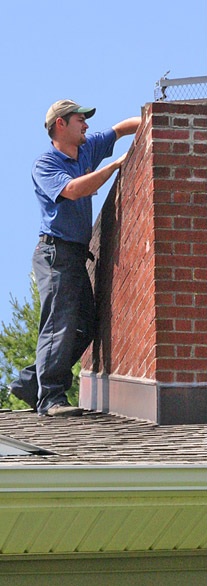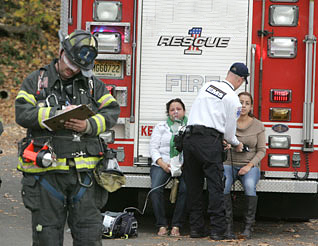Three Problems Solved by Chimney Inspections
 Summer is the best time to take care of many household maintenance items. An annual chimney inspection should be on every homeowner’s budget and maintenance checklist, in preparation for the coming cold blasts. When chimneys are not inspected routinely, various hazards can arise. There are three primary problems that typically occur when a chimney is not maintained, and each of them can lead to chimney damage and/or can also put the members of the household at risk. The top three potential problems that can be identified by having a chimney inspection are chimney fires, deterioration of the chimney structure, and carbon monoxide poisoning.
Summer is the best time to take care of many household maintenance items. An annual chimney inspection should be on every homeowner’s budget and maintenance checklist, in preparation for the coming cold blasts. When chimneys are not inspected routinely, various hazards can arise. There are three primary problems that typically occur when a chimney is not maintained, and each of them can lead to chimney damage and/or can also put the members of the household at risk. The top three potential problems that can be identified by having a chimney inspection are chimney fires, deterioration of the chimney structure, and carbon monoxide poisoning.
Out-of-Control Chimney Fires
Combustion gases from the fireplace go up the chimney, and they leave highly flammable deposits of creosote and soot behind every time there’s a fire. As the creosote builds up, the potential for a dangerous chimney fire becomes more and more of a threat. A hot ember that is airborne can ignite the flammable deposits, resulting in a chimney fire. In the past, many homeowners have made the deadly mistake of overlooking the dangers involved with chimney fires.
Even when a chimney fire is small and seems insignificant, it has extremely high temperatures. One chimney fire of any size can damage the chimney lining or flue. Once the lining is damaged, pyrolysis begins. When combustible objects are too near a heat source, such as a chimney without a sound lining, a chemical breakdown calls pyrolysis occurs. Sooner or later, those combustible materials will often burst into flames without warning and without the need for direct contact with flames. Because of the intense heat of chimney fires, if the fire spreads due to pyrolysis, there is rarely enough time for occupants of the household to all make it out safely.
Chimney fires often cause damage to the chimney structure because the intense fires are capable of cracking mortar. The potential for a roof fire is increased when the chimney mortar is damaged.
By getting a chimney inspection, the level of creosote buildup can be determined. As appropriate, a chimney cleaning will be recommended. When a fireplace is used regularly in winter, an annual chimney cleaning is virtually always needed, to eliminate creosote buildup and the risk of a chimney fire.
Chimney Structure Deterioration
Signs of a deteriorating chimney structure include such things as a cracked chimney crown, leaky flashing, and damaged mortar. If these issues aren’t addressed, the cost to repair them gets more and more expensive. Defects in the chimney can also result in deadly amounts of carbon monoxide being leaked into the home, endangering occupants.
Carbon Monoxide Poisoning
 There are various situations with the chimney and fireplace that can cause toxic gases to enter the home. The most dangerous of the gases is carbon monoxide, which is the leading cause of poisoning fatalities in the U.S. Chimney professionals have the experience and knowledge to identify all problems associated with carbon monoxide. The first piece of advice we give all homeowners who have fireplaces and other fuel-burning appliances is to install carbon monoxide detectors and ensure that the batteries in use are in working order. The buildup of gas that leads to exposure to deadly carbon monoxide can be caused by numerous things, including:
There are various situations with the chimney and fireplace that can cause toxic gases to enter the home. The most dangerous of the gases is carbon monoxide, which is the leading cause of poisoning fatalities in the U.S. Chimney professionals have the experience and knowledge to identify all problems associated with carbon monoxide. The first piece of advice we give all homeowners who have fireplaces and other fuel-burning appliances is to install carbon monoxide detectors and ensure that the batteries in use are in working order. The buildup of gas that leads to exposure to deadly carbon monoxide can be caused by numerous things, including:
- Chimney obstructions, including heavy deposits of creosote;
- Rusted heat exchange;
- Deterioration of the chimney structure; and
- A broken chimney connector pipe on a fuel-burning appliance.
If you haven’t scheduled your annual chimney inspection yet, give us a call. All of our chimney technicians are qualified and experienced professionals with a dedication to providing excellent service to our customers throughout the New York area.








